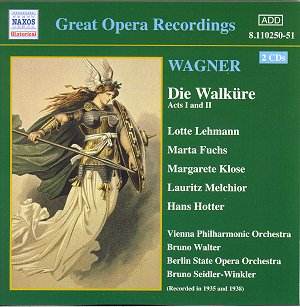It’s good that Naxos has got around to this classic
set of the first two Acts of Die Walküre, which for all its
attendant recording troubles has retained a prestigious place
in the recording history of the work. It enshrines a brace of
performances, by Lehmann and Melchior, the equal of any on disc
and conducting by Walter of felicitous articulacy – quite light
but certainly not without power when required. The complexities
of the recording history are probably well enough known – in brief
the intention was to record the whole work in Berlin but political
circumstances meant a move to Vienna where Act I was recorded
in 1935, along with parts of Act II. Financial costs stymied the
project in Vienna and the remainder of the second Act was finally
completed in Berlin in 1938, Bruno Seidler-Winkler standing in
for the obviously absent Walter.
The first thing to note is the extraordinary
splendid sound that the contemporary engineers extracted from
the Musikverein in 1935. Its immediacy and forward quality are
immediately apparent and there is little surface noise. The competition
comes from Danacord and EMI itself, which issued its version most
recently in 1992 though in a production note Mark Obert-Thorn
points out that a recent EMI release cut some of the Act II music
– I’m not sure if that is the reissue he has in mind.
Given the excellence of the engineering, the
low level of surface noise and the fine quality of the Victor
pressings one can listen with almost uninterrupted pleasure to
the performance. And what a performance – from Melchior’s first
weary entrance (Was Herd dies auch sei) and Lehmann’s exceptionally
vivid characterisation of every part of her role in which her
urgency and passion are to the fore, we can hear everything that
was most admirable in these great artists’ performances. In this
first scene we can also hear Walter’s complexly significant part
in his revelation of orchestral detail: counter themes, expressive
string and wind solos, motivic strands and so on. The first of
these is the deeply expressive cello solo (Buxbaum?). You can
also hear the sense of fluent continuity that Walter generates
(listen to the basses, horns and clarinets in the Siegmund-Sieglinde
dialogue immediately before Scene III in this respect, as well,
for confirmation of his control of the colour and pacing of this
movement - beginning Einen Unseiligen labtest du).
Hunding is Emanuel List, then only 47 and only
two years older than Melchior, but sounding less steady in his
line (held notes are a particular problem), though still profoundly
characterful. In matters of subtlety he has to yield though to
his younger colleague; Melchior’s vibrato usage in the Scene II
passage starting with Sieglinde’s Friedmund darf ich nicht
heissen is a small study in itself. Lehmann’s vitality and
multi-faceted impersonation burns strongly throughout the length
of the recording sessions. An exact contemporary of List her voice
has retained its freshness and strength untroubled by technical
frailty. Du bist der Lenz sees both Lehmann and Melchior
inspiring each other to still further heights of musico-expressive
understanding, her vitality spurring his increasing nobility of
utterance, all the while underpinned by Walter’s forward moving
conducting.
Marta Fuchs is Brünnhilde and we can hear
her here in her largest commercial recording undertaking. Her
entry in Act II Scene I (Nun zäune dein Ross) meeting
Hans Hotter’s Wotan shows the power and perfect intonation she
habitually displayed. Hotter, by some distance the youngest cast
member, was then only twenty-six (the same number of years Lehmann
had behind her as an opera singer!) and he is in clear and fresh
voice, not really yet the mesmeric stage creature he was to become,
with the voice rounded and true without the cavernous power that
was to develop over the next two decades or so. The high point
of his singing is the weary, hollowed-out tone he exhibits in
Act II Scene II (O heilige Schmach!) followed immediately
by the core hardening in his meeting with Brünnhilde. Margarete
Klose, like Walter a Berliner, is a fiery but super-subtle Fricka
with expressive colouration in her vocal production and a sense
of almost conversational inevitability about her impersonation.
It’s noticeable that however fine the Berlin
sessions are the orchestra there is not quite the receptive and
colour-strewn instrument that responds so well for Walter (winds
and strings especially). Seidler-Winkler was an experienced conductor
and an habitué of the Berlin recording studios but was
not Walter’s equal and his portion of the recording doesn’t flow
quite as well as in Vienna – but it’s marginal.
Problems in the recording? There were a few cuts
in the Wotan-Fricka scene in Act II and Wotan’s Narration, some
poor horn tuning in Act II Scene IV (Siegmund! Sieh
auf mich) and one less than imperceptible side join; also
some muffled but audible crackle in one of the sides used in Act
II Scene II. Otherwise all is well – with potted biographies and
storyline and Tully Potter’s introduction to the recording history
of the work.
Jonathan Woolf
